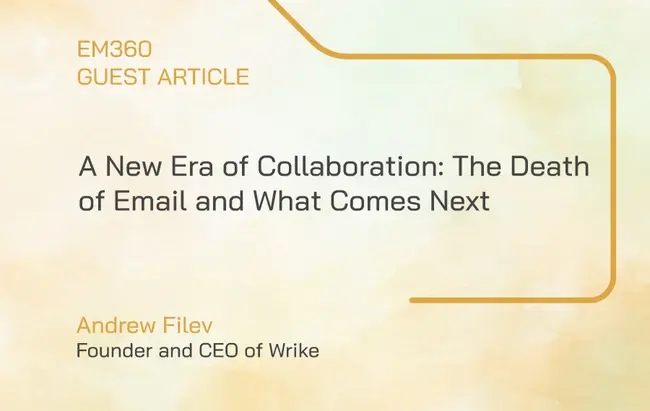Andrew Filev, Founder and CEO of Wrike
Since the 1970s, email has reigned as the go-to tool for business communication and collaboration. It’s often the first thing we look at when we open our laptops in the morning. For some of us, it’s the last thing we check on our phones before we go to bed.
However, since the first email was sent, the business landscape has become a lot more complex. Global networks and a never-ending stream of tools and processes can make it harder to keep track of the day-to-day. In the industrial economy, business leaders can chart huge projects by planning ahead for six months. But this world is so volatile that everything can change in an instant – as we all witnessed in March last year.
Which begs the question; is a tool that was first used and created over 50 years ago really the most efficient way to conduct and manage business today? What are email platforms going to be used for in the future and are they necessary?

Goodbye, email
When email first burst onto the scene, it revolutionised the business landscape. Messages and even files between co-workers no longer had to be hand delivered or sent in the post. Instead, they could be sent almost immediately anywhere around the world. All you needed was a computer. It was probably one of the biggest breakthroughs in terms of communication ever witnessed.
However, over the years email has become overused and overtired. In some cases, it has even become a direct threat to overall productivity. For example, a recent study discovered that people in the workplace spend 3.1 hours per day on average sending and checking their emails. That’s 15.5 hours per week, or 20 full weeks of the year. The same study calculated that this means a business which has a 200-strong workforce on the UK minimum wage would pay its staff £1.2m each year for reading and sending emails. To make matters worse, around half of this time is actually being wasted needlessly checking for updates, deleting spam and sending personal emails.
Email also presents challenges when it comes to effective collaboration. The last 18 months have fundamentally shifted the way that we think about the concept of ‘work’. As we continue to move away from full-time office-based interaction and towards a hybrid workplace, employees must maintain an online presence and be reachable, regardless of where they are based. They must also have visibility into their team’s work and reciprocate that visibility. Instant - yet structured and effective - communication is more important than ever and becoming a modern, agile enterprise is a dream worth chasing.
However, for many businesses, email stands in the way of this dream. Threads between multiple recipients are often complex and hard or tedious to manage. It can also be difficult to find specific information quickly which becomes an issue if any tasks or questions are time sensitive. There’s no doubt that this new reality calls for a new set of cultures, processes and tools and there’s no better time to start adopting them than today.
Becoming a modern, agile enterprise
Recent research discovered that the most engaged – and therefore productive - employees cite enjoying the work they do (45%) as the reason, closely followed by being able to collaborate well with their colleagues (42%). Whilst the work needs to remain the same, the ability to collaborate has seen a shift in recent years and – even more noticeably – in recent months. Businesses need to ensure that their staff are able to remain connected and have instant, easy visibility into the work being done, especially when working remotely. Email is no longer doing the job, which is where collaborative work management tools come in.
Such technologies make communication and collaboration instant. They bring defined processes to every single task, becoming the digital assembly line for all aspects of work and keeping associated documents and information about assignments together. This helps to eliminate silos and streamline teams to ensure that everyone is on the same page, no matter where they are working from. The ability to keep all communication in one place also reduces the need to trawl through thousands of emails in order to get up to date with activity. All context and conversations will be ordered together chronologically so individuals can find any proof points they need with ease.
These technologies can enable this instant level of communication, whilst also allowing individuals to switch off when they need to. For employees, constant email notifications can quite easily become overwhelming. It’s all too easy to open one email and get distracted, finding yourself down an hour-long rabbit hole. Daily notifications aren’t going anywhere, but a work management tool can help to minimise notifications by streamlining processes and keeping apps in one place.
Yes, email has undoubtedly served us well, but it’s time to make a change. As we emerge into the next chapter of business, the most successful organisations will be those that continue to streamline processes and collaboration. Newer technologies – such as collaborative work management tools – will bring the modern, agile enterprise to life.







Comments ( 0 )